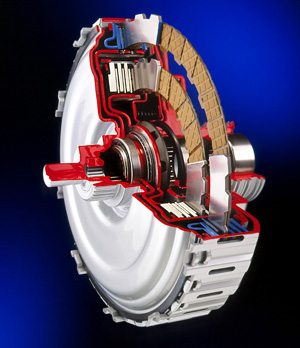
With dual-clutch transmissions gaining traction as viable means to improve vehicle efficiency, emissions, drivability and performance, DCT-pioneer BorgWarner Inc. is forging ahead with plans for next-generation systems targeting new markets and a wider array of applications.
At full launch of all future contracts, production of the supplier’s DualTronic DCT systems is expected to jump 500% from current levels by 2013 to 2.3 million units annually, says Bernd Matthes, president and general manager-BorgWarner Transmission Systems.
Included in the supplier’s 27 near-term programs are DCT applications for entry-level cars in emerging markets, hybrid-electric vehicles and diesel engines.
The outlook for DCT systems was highlighted at the recent Tokyo Motor Show, where Nissan Motor Co. Ltd. unveiled the ’08 GT-R sports car, one of the most anticipated new vehicles in years and the first volume application for dual-clutch technology in a high-powered sports car.
“This is another key event in the globalization of dual-clutch transmissions, launching BorgWarner’s DualTronic technology in a Japanese transmission for the first time,” Matthes says of the 480-hp GT-R. “It is also the world’s first transaxle dual-clutch transmission – front engine and rear transmission – the perfect balance for sports cars.”
Introduced in 2002 on several Volkswagen AG models as the Direct Shift Gearbox (DSG), the DualTronic DCT systems combine the smoothness of an automatic transmission with the fuel economy and performance gains of a manual gearbox through use of an integrated shifting module containing a pair of concentric clutches.

Initial applications focused primarily on horizontally opposed powertrain layouts in small, front-wheel-drive vehicles, such as the VW GTI and R32, as well as the Audi TT and A3.
With the exception of a low-volume application in the 1,001-hp Bugatti Veyron 16.4 supercar, the first DCT systems were not aimed at high-powered vehicles with longitudinal-engine placements and rear-wheel-drive. Until now.
Similar to VW’s DSG, the all-wheel-drive GT-R’s gearbox has six forward gears and is operated by either a console-mounted shifter or paddles on the steering wheel. With shift times in certain situations dropping below 100 milliseconds, the new gearbox will be crucial to the lofty performance expected of the GT-R, as well as allow it to use less fuel and be easier to drive, BorgWarner says.
Included in the GT-R’s DCT system are the supplier’s dual-clutch module, clutch-control and shift-actuation systems and synchronizer assemblies. The electro-hydraulic components are integrated into a conventional manual-type transaxle.
As with most existing DCT applications, the GT-R uses a wet-clutch setup with its friction plates immersed in oil. However, BorgWarner earlier this year released its first dry-clutch unit, a 7-speed DSG system designed for small, FWD VW models.
Benefits of the oil-less clutch arrangement include improved efficiency and simplicity. But without the added lubrication of a wet-clutch, heat and friction losses are increased.

VW says it will limit applications of the new DSG to engines with torque ratings of 148 lb.-ft. (200 Nm) or less.
BorgWarner expects to release its second-generation DCT in 2010, which will feature better mechatronics, reduced pressure leakage from solenoid actuators and a new “humid,” or moist-clutch design, Matthes tells Ward’s.
Through optimization of friction materials, thermal management and control systems, the new clutch will require less lubricant and a smaller pump. Although not a true dry-clutch setup, the moist clutch will offer better reliability, while also providing an additional 2% improvement in fuel economy on top of the average 5% boost from a wet-clutch DCT, the company says.
However, the greatest potential for growth is in emerging markets, such as China, India and Russia, where BorgWarner plans to market a new DCT system specifically designed to meet the needs of these growing regions.
Currently referred to as the micro-DCT (a formal name has yet to be chosen), this new gearbox, which is aimed at vehicles with small-displacement engines in the 1.3L-1.4L range, has a simplified design with many common parts for reduced costs.
Unlike existing DCT units, which have two clutches – one each for odd and even gears – arranged on a single input shaft, the micro-DCT’s clutches are configured onto two parallel shafts. The two clutches are identical, but separating them allows for multiple shift ratios to be used.
In addition, the modular design can handle up to 221 lb.-ft. (300 Nm) of torque and can be fitted to either 5- or 6-speed gearboxes in both FWD and RWD applications.
This architecture, which is proprietary to BorgWarner, offers a “slight loss in efficiency, but full functionality,” Matthes says, noting the micro-DCT carries a 20% cost savings compared with current units.
Other benefits, he adds, include a 13% jump in fuel economy, better top-end speed and faster acceleration compared with automatic transmissions currently in production.
Meanwhile, the supplier is looking toward HEVs as another avenue for DCT expansion.
The modular design of the DualTronic components is well suited to hybrid applications, as electric drive motors can be integrated into the system with relative ease. In addition, the inherent low-inertia efficiency of the DCT design improves the effectiveness of regenerative brakes, while enhancing performance and drivability – something not always associated with HEVs.
Of the 27 DCT programs BorgWarner has lined up for production, one is an HEV application for the 2010-2011 timeframe. The vehicle will first be launched in Europe and then migrate to the U.S., Matthes says, adding a mild-hybrid application, mated to a diesel engine with start/stop capability, also is in the works.
Other programs include two high-volume longitudinal-engine applications within the next two years.
In addition to contracts with VW, Audi and Nissan, BorgWarner is supplying Getrag GmbH & Cie KG with DCT components for programs with five other global auto makers, including Ford Motor Co. and Chrysler LLC.




